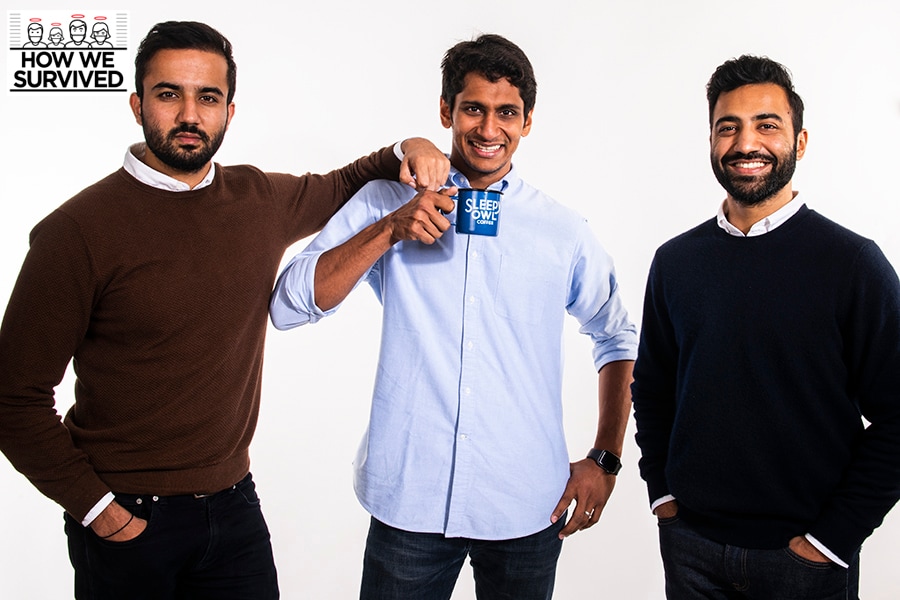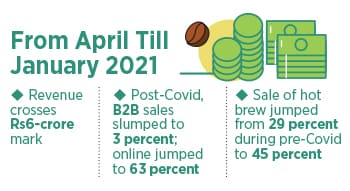How Sleepy Owl switched from cold to hot to survive the pandemic
How hot brew helped Sleepy Owl shed its cold brew tag and survive the pandemic chill


 Image: Amit Verma
Image: Amit Verma
For close to four years, Ajai Thandi, Ashwajeet Singh and Arman Sood were addicted to a caffeinated life. The three friends started ready-to-brew coffee brand Sleepy Owl in June 2016, and had scaled it up handsomely till March 2020. From a revenue of Rs1.8 crore in FY19, sales jumped by almost 300 percent to Rs5.2 crore in March 2020 the cold brew brand expanded its reach to over 1,000 general and modern retail outlets across Delhi-NCR, and Mumbai and B2B business made up close to one-third of sales for Sleepy Owl. Another high for the venture was $1.5 million round of funding in September 2019 from a clutch of investors such as Rukam Capital, AngelList India and DSG Consumer Partners. Clearly, a lot was happening over coffee for the fledgling brand, which was all set for a hooting summer of 2021.
Then came the pandemic. What followed next was a wake-up call for Sleepy Owl, and sleepless nights for the co-founders. Institutional sales slumped to nought airlines business got grounded and retail sales evaporated. The co-founders developed cold feet. Reason: Rs15 lakh-inventory of cold brew bottles largely for institutional sales in Delhi-NCR and Mumbai was stranded. With a product shelf life of a few months and no clarity on the lockdown blues, Sleepy Owl was staring at an eventuality of discarding all the bottles. The startup quickly came up with a break-proof packaging to ship bottles across India the co-founders loaded their cars with cold brew and went direct to consumers in terms of delivering and Sleepy Owl managed to exhaust the inventory over the next few months.

A sip, though, does not make a summer. A prolonged lockdown, and a subsequent staggered unlockdown, brought in their wake another set of serious problems. As the business gathered steam, Sleepy Owl ran out of coffee. Sourced directly from the farms of Chikmagalur in Karnataka, consignments of Arabica coffee beans got stuck in the highways for over 45 days. There was another irritating glitch. Sleepy Owl ran out of packaging as well. The survival hack, though, was a smart quick fix: Using the packs of ‘dark roast’ variant to sell ‘original cold brew’. The brand apologised for the switch. ‘We are sorry for the switch’, it underlined in a sorry note attached with every such pack. The packaging of original cold brew, it stressed, has been slightly delayed due to the pandemic. “We didn’t want to keep you waiting for your brew. So this is a quick-fix,” the note read.
Quick fix, though, didn’t result in quick sales. With ready-to-drink bottles and cold brew losing steam, Sleepy Owl needed a booster caffeine dose. And it did come in the form of hot brew bags—coffee in a tea bag—which the startup rolled out during the winter of 2019. Priced at Rs300 for a box of 10 pouches, Brew Bags—which made up around 29 percent of sales clocked by Sleepy Owl before Covid—gained heady traction. Look at the numbers. Post-Covid, Brew Bags made up for 45 percent of sales 36 percent was contributed by cold brew blend and ready-to-drink chipped in with 19 percent, a fall from 35 percent before Covid.
 The co-founders of Sleepy Owl loaded their cars with cold brew and went direct to consumers in terms of delivering and the team managed to exhaust the inventory over the next few months
The co-founders of Sleepy Owl loaded their cars with cold brew and went direct to consumers in terms of delivering and the team managed to exhaust the inventory over the next few months
Sleepy Owl was still not out of the danger zone. Reason: It was fast running out of capital. The startup, which had raised its last round in September 2019—some seven months before the lockdown—had exhausted almost half the amount by March 2020. “We had only six months of runway left,” recalls Thandi. With the country going under a lockdown and offline shutting down, the possibility of raising another round was almost next to zero. There was only one solution: Rigorous fiscal discipline. Thandi and his team opted for zero budgeting eliminated all the marketing, advertising and other operational expenses that could be done away with and managed to stretch the runway to 18 months.

Getting lean, Thandi reckons, is the best thing to happen for the startup. “Earlier, we were chasing revenue targets at all costs,” he rues. It didn’t matter, he lets on, how much money the startup was throwing to achieve the target. “There’s no fiscal discipline, especially when it came to online advertising,” he recalls. Thandi puts the blame on the habit that any collegegoer could be easily guilty of: Submitting the assignment on the last day. Even if you get a month to submit your work, Thandi explains, you would end up doing it on the last day. Sleepy Owl too had cloned the habits of errant student. “We should have been fiscally disciplined. We knew this, but never practised it,” he accepts. “Now there is no going back. It can’t be growth at any cost,” he adds. The startup will keep its offline focus on two places it started with—Delhi-NCR and Mumbai—and doesn’t intend to expand horizontally anytime soon.
The backers are delighted to see course correction. When the curve ball came in the form of Covid, it became extremely imperative for Sleepy Owl to relook at the business, and prepare for what was to come, contends Deepak Shahdadpuri, managing partner at DSG Consumer Partners. Zero-based budgeting not only optimised resources, but also helped in fiscal discipline. The goal was to extend the runway and run the business with fiscal prudence and capital efficiency. “Bringing down the financial burn from 100 percent of revenue to single digit percentage points is not an easy task for any brand,” he adds.

For Sleepy Owl, the pandemic has been a much-needed wake-up call and a coffee break. A lot might still happen if one takes caffeine in moderation.
First Published: Mar 08, 2021, 17:49
Subscribe Now